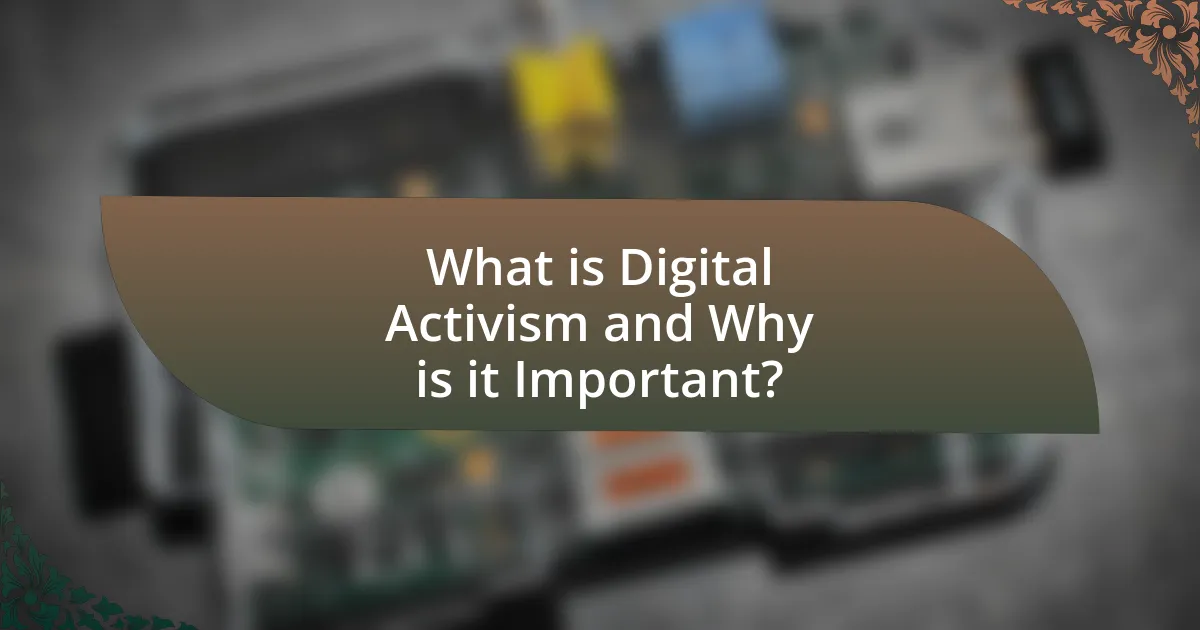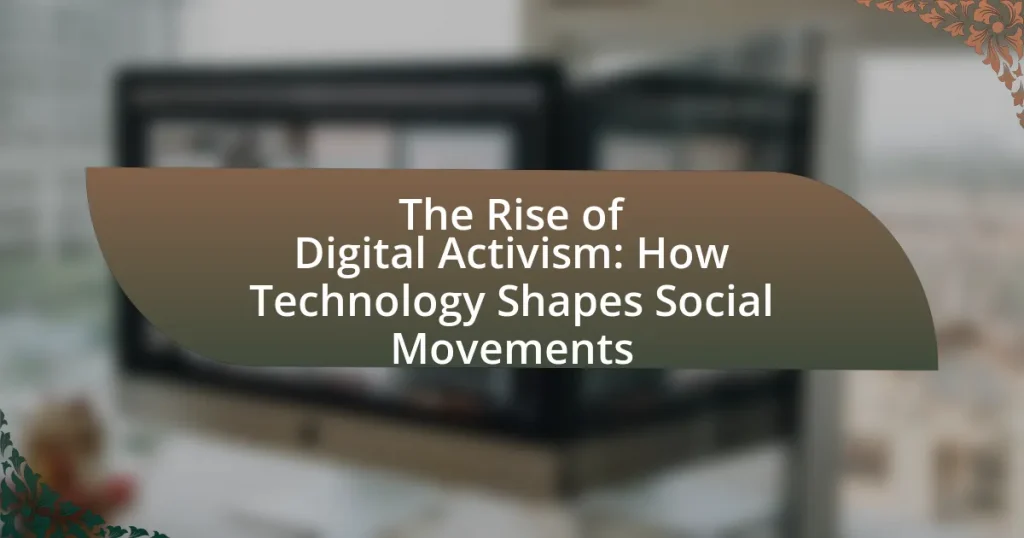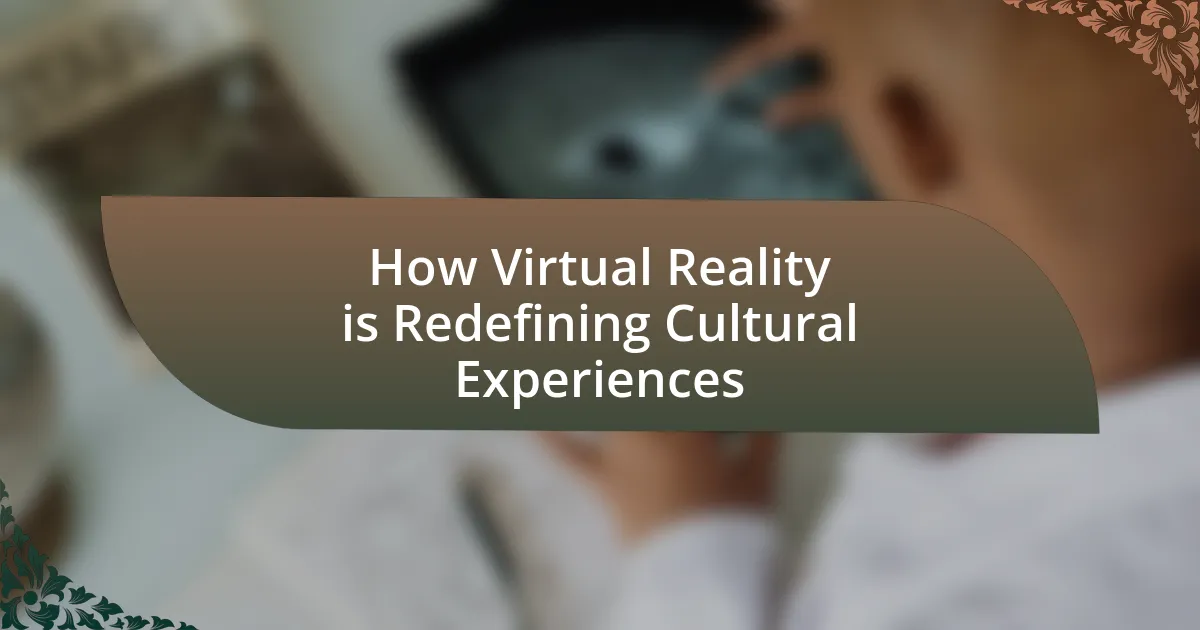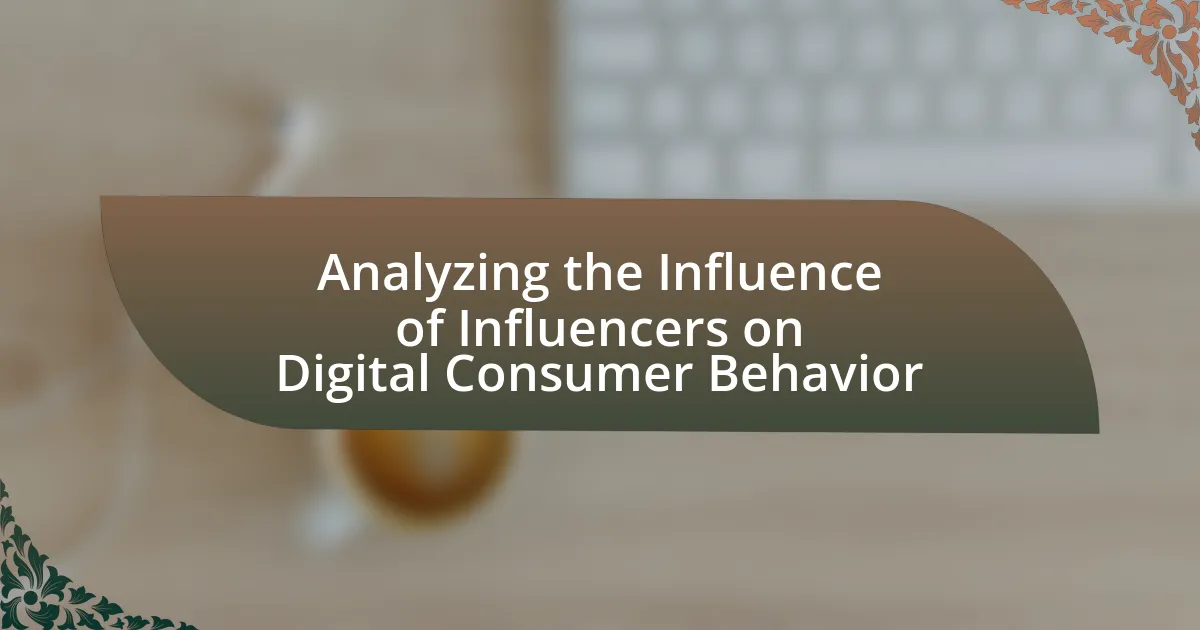Digital activism refers to the use of digital tools and platforms to advocate for social change and raise awareness about various causes. This article explores the evolution of digital activism, highlighting its significance in contemporary movements such as #BlackLivesMatter and #MeToo, which have effectively utilized social media to mobilize support and influence public discourse. It examines the historical events that have shaped digital activism, the role of technology and social media in facilitating organization and communication, and the motivations driving individuals to engage in online movements. Additionally, the article addresses the challenges faced by digital activists, the strategies employed in digital campaigns, and the ethical considerations surrounding privacy and misinformation. Ultimately, it underscores how digital activism can lead to real-world change and the responsibilities of activists in the digital landscape.

What is Digital Activism and Why is it Important?
Digital activism is the use of digital tools and platforms to promote social change and advocate for various causes. It is important because it enables rapid mobilization, amplifies marginalized voices, and facilitates global awareness of social issues. For instance, movements like #BlackLivesMatter and #MeToo have utilized social media to reach millions, influencing public discourse and policy changes. According to a 2020 study by the Pew Research Center, 69% of Americans believe social media is an effective tool for activism, highlighting its significance in contemporary social movements.
How has digital activism evolved over time?
Digital activism has evolved significantly from early online forums and email campaigns in the 1990s to the widespread use of social media platforms for organizing and mobilizing movements today. Initially, digital activism relied on basic internet tools, such as websites and mailing lists, to raise awareness and gather support for various causes. The advent of social media in the 2000s transformed this landscape, enabling real-time communication and the rapid dissemination of information, which played a crucial role in movements like the Arab Spring in 2010-2011, where platforms like Twitter and Facebook were instrumental in organizing protests and sharing updates. Furthermore, the rise of mobile technology has facilitated grassroots activism, allowing individuals to participate in campaigns from anywhere, exemplified by movements such as Black Lives Matter, which gained momentum through viral hashtags and online engagement. This evolution reflects a shift towards more decentralized and participatory forms of activism, leveraging technology to amplify voices and foster global solidarity.
What historical events have influenced the rise of digital activism?
The rise of digital activism has been significantly influenced by events such as the Arab Spring, the Occupy Wall Street movement, and the Black Lives Matter protests. The Arab Spring, which began in 2010, showcased how social media platforms like Twitter and Facebook could mobilize protests and disseminate information rapidly, leading to political changes in several Middle Eastern countries. Occupy Wall Street in 2011 utilized digital tools to organize and spread awareness about economic inequality, demonstrating the power of online networks in grassroots movements. Similarly, the Black Lives Matter movement, which gained momentum in 2013, effectively used social media to raise awareness about racial injustice and police brutality, mobilizing global support and fostering a digital community for activism. These events illustrate how technology has transformed traditional activism into a more immediate and widespread form of engagement.
How have social media platforms contributed to this evolution?
Social media platforms have significantly contributed to the evolution of digital activism by providing a space for rapid information dissemination and community mobilization. These platforms enable activists to share messages, organize events, and rally support in real-time, which has been evidenced by movements such as the Arab Spring, where Twitter and Facebook played crucial roles in coordinating protests and spreading awareness. Additionally, studies show that social media can amplify marginalized voices, allowing for broader participation in social movements, as seen in the Black Lives Matter movement, which gained momentum through hashtags and viral content. This accessibility and immediacy of communication have transformed traditional activism into a more dynamic and inclusive form, demonstrating the profound impact of social media on contemporary social movements.
What role does technology play in shaping social movements?
Technology plays a crucial role in shaping social movements by facilitating communication, mobilization, and awareness. Social media platforms, for instance, enable activists to disseminate information rapidly, organize events, and connect with supporters globally. The Arab Spring is a notable example, where platforms like Twitter and Facebook were instrumental in coordinating protests and sharing real-time updates, leading to significant political changes in several countries. Additionally, data analytics tools allow movements to target specific demographics effectively, enhancing their outreach and impact. Thus, technology not only amplifies voices but also transforms the strategies and effectiveness of social movements.
How do digital tools facilitate organization and mobilization?
Digital tools facilitate organization and mobilization by enabling efficient communication, coordination, and resource sharing among activists. These tools, such as social media platforms, messaging apps, and online collaboration software, allow individuals and groups to quickly disseminate information, rally support, and organize events. For instance, during the Arab Spring, platforms like Twitter and Facebook were instrumental in coordinating protests and sharing real-time updates, leading to significant political changes in several countries. Additionally, research from the Pew Research Center indicates that 69% of Americans believe social media is an effective tool for organizing events and movements, highlighting its role in modern activism.
What impact does technology have on communication within movements?
Technology significantly enhances communication within movements by facilitating rapid information dissemination and fostering global connectivity. Social media platforms, for instance, allow activists to share messages instantly, mobilize supporters, and coordinate actions across vast distances. According to a study by the Pew Research Center, 69% of adults in the U.S. use social media, which has become a crucial tool for organizing protests and raising awareness about social issues. Furthermore, technology enables real-time updates and engagement, allowing movements to adapt quickly to changing circumstances and maintain momentum. This interconnectedness has been pivotal in movements like the Arab Spring, where platforms like Twitter and Facebook played essential roles in organizing protests and sharing information.
Why do people engage in digital activism?
People engage in digital activism to amplify their voices and mobilize support for social causes. Digital platforms provide a space for individuals to share information, organize events, and raise awareness quickly and broadly. For instance, the #BlackLivesMatter movement gained significant traction through social media, allowing activists to reach millions and influence public discourse on racial justice. This demonstrates that digital activism can effectively challenge traditional power structures and foster community engagement.
What motivations drive individuals to participate in online movements?
Individuals participate in online movements primarily due to a desire for social change, community engagement, and personal empowerment. The motivation for social change stems from a recognition of injustices or issues that individuals feel passionate about, prompting them to take action through digital platforms. Community engagement is driven by the need to connect with like-minded individuals, fostering a sense of belonging and collective identity. Personal empowerment arises from the ability to express opinions, share experiences, and influence others, which is facilitated by the accessibility of online tools. Research indicates that 70% of participants in online movements cite a sense of community as a key motivator, highlighting the importance of social connections in driving engagement.
How does digital activism empower marginalized communities?
Digital activism empowers marginalized communities by providing them with platforms to amplify their voices and mobilize support. Through social media and online campaigns, these communities can share their experiences, raise awareness about injustices, and connect with allies globally. For instance, the #BlackLivesMatter movement utilized Twitter to highlight systemic racism and police brutality, leading to widespread protests and policy discussions. This digital engagement not only fosters solidarity but also influences public opinion and policy changes, demonstrating the tangible impact of online activism on societal issues.
How does digital activism differ from traditional activism?
Digital activism differs from traditional activism primarily in its reliance on digital platforms for mobilization and communication. While traditional activism often involves in-person gatherings, protests, and physical outreach, digital activism utilizes social media, websites, and online campaigns to engage supporters and spread messages rapidly. For instance, the #BlackLivesMatter movement gained significant traction through Twitter and Facebook, allowing for immediate global awareness and participation, contrasting with the slower, localized efforts typical of traditional activism. This shift enables broader reach and faster dissemination of information, as evidenced by the rapid organization of events like the Women’s March in 2017, which was largely coordinated online.
What are the advantages of digital activism over traditional methods?
Digital activism offers several advantages over traditional methods, primarily through its ability to reach a larger audience quickly and efficiently. Unlike traditional activism, which often relies on physical gatherings and print media, digital activism utilizes social media platforms, websites, and online campaigns to mobilize support and disseminate information rapidly. For instance, the Ice Bucket Challenge in 2014 raised over $115 million for ALS research in just a few months, showcasing how digital platforms can amplify fundraising efforts and awareness campaigns. Additionally, digital activism allows for real-time engagement and interaction, enabling activists to respond to events as they unfold, which is less feasible with traditional methods. This immediacy can lead to heightened public awareness and pressure on decision-makers, as seen in movements like #BlackLivesMatter, which gained momentum through viral social media posts. Overall, the speed, reach, and interactive nature of digital activism significantly enhance its effectiveness compared to traditional activism.
What challenges do digital activists face compared to their traditional counterparts?
Digital activists face unique challenges compared to traditional activists, primarily due to the nature of online platforms and the digital landscape. One significant challenge is the prevalence of misinformation and disinformation, which can undermine campaigns and create confusion among supporters. For instance, a study by the Pew Research Center found that 64% of Americans believe that misinformation has a major impact on public opinion, complicating the efforts of digital activists to convey accurate messages.
Additionally, digital activists often encounter issues related to surveillance and privacy, as their online activities can be monitored by governments or hostile entities. This was highlighted during the Arab Spring, where activists faced repercussions for their online organizing. Furthermore, the rapid pace of technological change can make it difficult for digital activists to keep up with new tools and platforms, potentially limiting their effectiveness.
In contrast, traditional activists may rely on established networks and face fewer immediate threats from misinformation, but they still contend with logistical challenges such as organizing physical events and mobilizing supporters in person. Overall, while both forms of activism face obstacles, the digital realm introduces specific complexities that require different strategies and considerations.
What are the key strategies used in digital activism?
Key strategies used in digital activism include social media mobilization, online petitions, and hashtag campaigns. Social media mobilization allows activists to reach a broad audience quickly, as evidenced by the #BlackLivesMatter movement, which gained global attention through platforms like Twitter and Instagram. Online petitions, such as those hosted on Change.org, enable individuals to gather support for specific causes, demonstrating the power of collective action; for instance, a petition to end the use of plastic straws garnered over 1.5 million signatures. Hashtag campaigns create a unified message and foster community engagement, as seen with the #MeToo movement, which highlighted issues of sexual harassment and assault, leading to significant societal discussions and policy changes. These strategies leverage technology to amplify voices and drive social change effectively.
How do hashtags and viral campaigns influence public awareness?
Hashtags and viral campaigns significantly enhance public awareness by creating a unified message that can rapidly spread across social media platforms. These digital tools enable individuals and organizations to mobilize support, share information, and engage a broader audience, often leading to increased visibility for social issues. For instance, the #BlackLivesMatter movement gained global attention, resulting in widespread discussions about racial injustice and police brutality, demonstrating how a simple hashtag can catalyze social change. Research indicates that campaigns utilizing hashtags can increase engagement rates by up to 100% compared to those without, highlighting their effectiveness in amplifying messages and fostering community involvement.
What role do online petitions and crowdfunding play in digital movements?
Online petitions and crowdfunding serve as critical tools in digital movements by facilitating collective action and resource mobilization. Online petitions enable individuals to express support for specific causes, often leading to increased visibility and pressure on decision-makers; for instance, the 2017 petition against the travel ban in the United States garnered over a million signatures, demonstrating public opposition and influencing policy discussions. Crowdfunding platforms allow activists to raise financial support for their initiatives, exemplified by the successful fundraising campaigns for the Black Lives Matter movement, which raised millions to support protests and community programs. Together, these mechanisms enhance engagement, amplify voices, and provide necessary resources, thereby significantly impacting the effectiveness and reach of digital activism.
How can digital activism lead to real-world change?
Digital activism can lead to real-world change by mobilizing large groups of people quickly and effectively, influencing public opinion, and pressuring decision-makers. For instance, the #BlackLivesMatter movement utilized social media platforms to raise awareness about racial injustice, resulting in significant policy discussions and changes in law enforcement practices across various cities in the United States. Research by the Pew Research Center indicates that 69% of Americans believe social media is an effective tool for activism, demonstrating its impact on societal engagement and legislative action.
What examples demonstrate the effectiveness of digital activism?
Examples that demonstrate the effectiveness of digital activism include the #BlackLivesMatter movement, which mobilized millions globally to address systemic racism and police brutality, leading to significant policy discussions and reforms. Another example is the Ice Bucket Challenge, which raised over $115 million for ALS research in a short period, showcasing how viral campaigns can generate substantial financial support for causes. Additionally, the Arab Spring utilized social media platforms to organize protests, resulting in political changes in several countries, illustrating the power of digital tools in facilitating social movements.
How do online movements transition to offline actions?
Online movements transition to offline actions through organized mobilization, community building, and strategic planning. Social media platforms facilitate the rapid dissemination of information, allowing activists to coordinate events, share resources, and rally support. For instance, the Black Lives Matter movement effectively utilized Twitter and Facebook to organize protests following incidents of police violence, demonstrating how online engagement can lead to significant offline demonstrations. Research indicates that 70% of participants in social movements reported being motivated by online interactions, highlighting the direct impact of digital activism on physical mobilization.
What ethical considerations arise in digital activism?
Ethical considerations in digital activism include issues of privacy, consent, misinformation, and the potential for harm. Privacy concerns arise when activists use digital platforms that may expose personal data or identities, risking retaliation or harassment. Consent is critical, as activists must ensure that individuals involved in campaigns are fully informed and agree to participate. Misinformation can spread rapidly online, leading to misinterpretations of issues and undermining the credibility of movements. Additionally, the potential for harm exists when digital activism inadvertently incites violence or backlash against marginalized communities. These considerations highlight the need for responsible practices in digital activism to protect individuals and maintain the integrity of social movements.
How do privacy concerns affect participants in digital movements?
Privacy concerns significantly impact participants in digital movements by limiting their willingness to engage and share information. When individuals fear surveillance or data breaches, they may refrain from expressing their opinions or participating in activism, which can hinder the overall effectiveness of the movement. For instance, a study by the Pew Research Center found that 86% of Americans have taken steps to protect their online privacy, indicating a widespread apprehension that can stifle open discourse and mobilization in digital activism. This reluctance can lead to a less diverse range of voices and ideas within movements, ultimately affecting their reach and influence.
What responsibilities do activists have when using digital platforms?
Activists have the responsibility to ensure the accuracy and credibility of the information they share on digital platforms. Misinformation can undermine movements and lead to public distrust, as evidenced by studies showing that false information spreads faster online than factual content. Additionally, activists must respect the privacy and safety of individuals involved in their causes, as breaches can lead to real-world harm. For instance, the 2011 Arab Spring highlighted the risks activists faced when personal data was exposed, leading to arrests and violence. Furthermore, activists should engage in constructive dialogue and foster inclusivity, as divisive rhetoric can alienate potential supporters and weaken movements.
How can individuals effectively engage in digital activism?
Individuals can effectively engage in digital activism by utilizing social media platforms to raise awareness, mobilize support, and create communities around specific causes. For instance, campaigns like #BlackLivesMatter have demonstrated how hashtags can unify voices and amplify messages, leading to significant social change. Research indicates that social media can increase participation in protests and civic engagement, as seen in the Arab Spring, where platforms like Twitter and Facebook played crucial roles in organizing and disseminating information. By sharing informative content, participating in online discussions, and collaborating with like-minded individuals, individuals can enhance their impact in the digital activism landscape.
What best practices should activists follow when using social media?
Activists should prioritize authenticity, engagement, and strategic messaging when using social media. Authenticity builds trust with followers, as seen in campaigns like #BlackLivesMatter, where personal stories and real experiences resonated deeply with audiences. Engagement is crucial; responding to comments and fostering discussions can enhance community involvement, as demonstrated by successful movements that utilized live Q&A sessions to connect with supporters. Strategic messaging involves clear, concise communication of goals and calls to action, which has proven effective in mobilizing support quickly, as evidenced by the rapid organization of protests through platforms like Twitter.
How can one measure the impact of their digital activism efforts?
One can measure the impact of their digital activism efforts through metrics such as engagement rates, reach, and conversion statistics. Engagement rates, which include likes, shares, and comments, indicate how well the content resonates with the audience. Reach measures the number of unique users who see the content, providing insight into the campaign’s visibility. Conversion statistics, such as the number of people taking action (e.g., signing a petition or donating), reflect the effectiveness of the activism in prompting real-world change. For instance, a study by the Pew Research Center found that social media campaigns can significantly increase public awareness and participation in social issues, demonstrating a direct correlation between digital activism and tangible outcomes.



